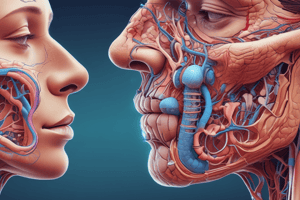Podcast
Questions and Answers
What differentiates obstructive lung disease from restrictive lung disease?
What differentiates obstructive lung disease from restrictive lung disease?
- Restrictive lung disease involves significant inflammation of the airways.
- Obstructive lung disease is characterized by decreased airflow. (correct)
- Restrictive lung disease results in increased airway resistance.
- Obstructive lung disease causes reduced lung expansion.
Which medication is commonly used as a reliever for acute asthma attacks?
Which medication is commonly used as a reliever for acute asthma attacks?
- Montelukast
- Fluticasone
- Salbutamol (correct)
- Prednisone
Which of the following is a typical feature of restrictive lung disease?
Which of the following is a typical feature of restrictive lung disease?
- Maintenance of diffusion capacity
- Decreased forced vital capacity (correct)
- Increase in total lung capacity
- Obstruction of airways
What happens to ventilation-perfusion ratios in conditions of lung disease?
What happens to ventilation-perfusion ratios in conditions of lung disease?
Which characteristic is true regarding the mechanics of ventilation?
Which characteristic is true regarding the mechanics of ventilation?
What is a primary indicator of gas exchange efficiency in the lungs?
What is a primary indicator of gas exchange efficiency in the lungs?
Which term describes the enlargement of air spaces with destruction of alveolar walls in lung disease?
Which term describes the enlargement of air spaces with destruction of alveolar walls in lung disease?
In the DRS ABCDE approach, what does 'D' signify?
In the DRS ABCDE approach, what does 'D' signify?
What characterizes restrictive lung disease?
What characterizes restrictive lung disease?
What effect does a decreased ventilation-perfusion (V/Q) ratio have on gas exchange?
What effect does a decreased ventilation-perfusion (V/Q) ratio have on gas exchange?
Which lung volume is defined as the amount of air inhaled or exhaled during normal breathing?
Which lung volume is defined as the amount of air inhaled or exhaled during normal breathing?
What is the primary factor that contributes to the mechanics of ventilation?
What is the primary factor that contributes to the mechanics of ventilation?
What does the pressure gradient between the alveoli and capillaries primarily drive during the gas exchange process?
What does the pressure gradient between the alveoli and capillaries primarily drive during the gas exchange process?
In the context of mechanics of ventilation, what does an increased resistance to airflow typically indicate?
In the context of mechanics of ventilation, what does an increased resistance to airflow typically indicate?
Which of the following conditions is most directly associated with an increased dead space in the lungs?
Which of the following conditions is most directly associated with an increased dead space in the lungs?
What happens to the FEV1/FVC ratio in patients with obstructive lung disease?
What happens to the FEV1/FVC ratio in patients with obstructive lung disease?
What is the primary function of the cilia in the respiratory system?
What is the primary function of the cilia in the respiratory system?
How does smoking adversely affect the ciliary function in the respiratory system?
How does smoking adversely affect the ciliary function in the respiratory system?
What does the V/Q ratio represent in the lungs?
What does the V/Q ratio represent in the lungs?
In the case of a shunt, what occurs in the lungs?
In the case of a shunt, what occurs in the lungs?
Which lung has fewer lobes, and why?
Which lung has fewer lobes, and why?
What is the significance of the pleura in lung function?
What is the significance of the pleura in lung function?
What physiological signs may indicate hypoxia in a patient?
What physiological signs may indicate hypoxia in a patient?
Which of the following is a potential consequence of ineffective cough in respiratory conditions?
Which of the following is a potential consequence of ineffective cough in respiratory conditions?
How does carbon dioxide move in obstructive respiratory conditions?
How does carbon dioxide move in obstructive respiratory conditions?
What role does the auxiliary muscle have in breathing during respiratory distress?
What role does the auxiliary muscle have in breathing during respiratory distress?
Which lung capacity is indicative of restrictive lung disease?
Which lung capacity is indicative of restrictive lung disease?
What results from hypoventilation related to CO2 levels?
What results from hypoventilation related to CO2 levels?
What symptom is commonly observed with respiratory infections affecting lung function?
What symptom is commonly observed with respiratory infections affecting lung function?
Why may a patient with chronic obstructive pulmonary disease (COPD) experience confusion?
Why may a patient with chronic obstructive pulmonary disease (COPD) experience confusion?
Flashcards are hidden until you start studying
Study Notes
Cilia and Mucous Function
- Cilia are hair-like structures that facilitate mucus clearance in the respiratory tract.
- Smoking and burns can cause damage to cilia and increase mucus production, hindering clearance.
- Aqueous layer lubricates cilia; disruptions arise from increased periciliary fluid (pulmonary edema) or dehydration.
- Viscous layer and ciliary movement can be impaired by hypersecretory conditions, like cystic fibrosis (CF) and bronchiectasis.
- Increased mucus volume and thickness linked to smoking, respiratory infections, and CF can obstruct airflow.
Ventilation & Perfusion (V/Q Mismatch)
- V/Q ratio is a measure of air flow into and out of alveoli versus blood flow to alveolar capillaries.
- A mismatch results in diminished oxygen supply or blood flow.
- Shunt occurs with reduced ventilation (blood supply without air), while dead space occurs with reduced perfusion (air presence without blood).
Heart and Lung Structure and Function
- Heart functions as a pump circulating blood; has four chambers (two atria, two ventricles).
- Right atrium receives deoxygenated blood from the body and pumps it into the right ventricle, which sends blood to lungs for oxygenation.
- Left atrium receives oxygenated blood from lungs and delivers it to the left ventricle, which pumps it throughout the body.
- Lungs are spongy organs located in the thoracic cavity; right lung has three lobes, left lung has two lobes to accommodate the heart.
- Bronchi branch from trachea, leading to smaller bronchioles and ending in alveoli where gas exchange occurs.
- Each lung is encased in a pleura, a double-layered membrane providing lubrication and reducing friction during breathing.
Cardiorespiratory Impairments
- Low oxygen readings on arterial blood gases (ABGs) or pulse oximetry indicate potential problems.
- Common symptoms include fatigue, shortness of breath, cyanosis, and reduced exercise capacity.
- Ineffective cough may be present in conditions like CF, bronchiectasis, or pneumonia.
- Mobility impairments can arise from decreased physical activity, increased bed rest, and decreased exercise tolerance.
Hypoxia and Oxygen Saturation
- ABGs assess blood gas levels, measuring oxygen and carbon dioxide pressures to evaluate respiratory status.
- Pathology indicated by low O2 saturation can lead to hypoxia, with potentially serious consequences for cellular function.
Common Respiratory Conditions and Management
- Obstructive lung diseases include asthma and COPD, characterized by airflow limitation.
- Restrictive lung diseases involve a reduction in lung volume due to stiffness or structural problems.
- Management for asthma includes controller medications (reducing inflammation) and reliever medications (bronchodilators).
- Additional therapies may include breathing exercises and non-drug management for severe cases.
Chest X-ray Interpretation
- Use DRS ABCDE approach for assessment:
- Details: Patient information, date of the imaging, and prior films for comparative purposes.
- Rotation: Assess if the patient is properly positioned (standing straight) during imaging.
General Assessment
- Assess weight-bearing status and required assistance levels when evaluating mobility.
- Monitor vital signs and recognize normative ranges, particularly for respiratory and cardiovascular conditions.
Studying That Suits You
Use AI to generate personalized quizzes and flashcards to suit your learning preferences.




